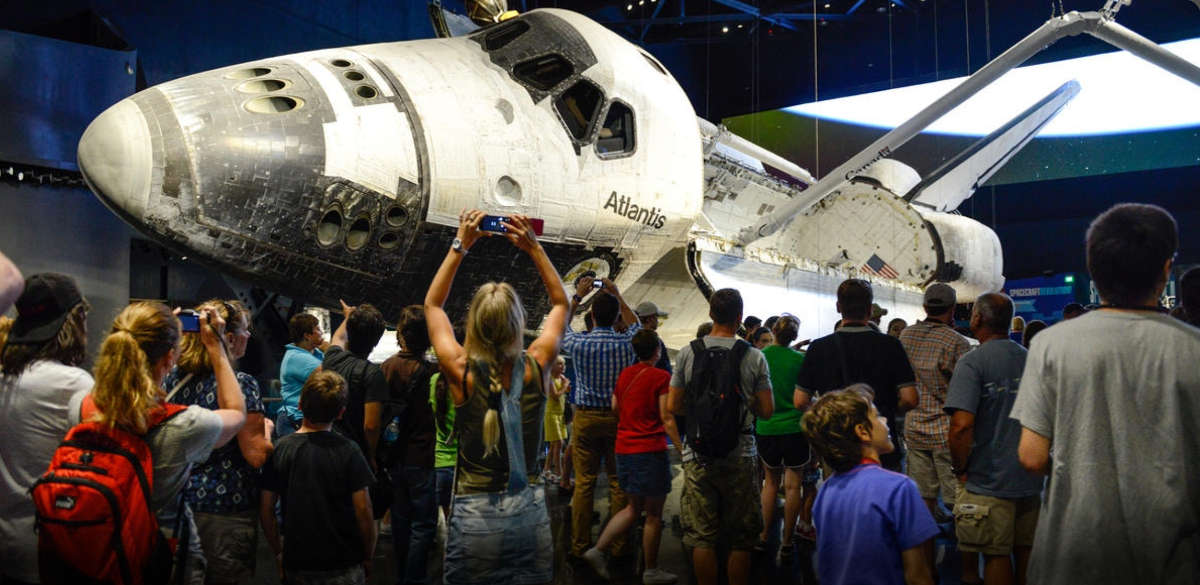In the picture
The shuttle 'Atlantis', in the museum at Cape Canaveral [NASA].
Launches are the basis of all space activity. However, an enormous infrastructure and preparation is necessary, and spaceports are capable of processing a large part of this infrastructure in a concentrated and combined manner at the same geographical area . Therefore, the possession of a spaceport on its own soil is a determining factor for decisive participation in the strategic and economic activity of the global space industry.
A spaceport is the geographic space chosen to carry out the development of projects of this caliber, especially the launch phase. This generally includes all activities and operations until the spacecraft is stabilized in its orbital position final, including all support activities. In addition to the final launch phase, activities in the development, manufacturing, test and maintenance phases may be carried out at the space center. Most orbital space launches have been carried out from terrestrial spaceports, but it is possible to do so from seaports.
A report report from the Center for Strategic & International Studies (CSIS) dedicated to spaceports recalled in 2019 that these were born linked to missile testing and some have continued to be linked to the military sector, as is the case of the satellite launch center in Wenchang (China), which shares facilities with a military base of the People's Liberation Army (PLA). Also, more than 60 years ago, the Soviet Union launched the first artificial satellite into orbit from the Baikonur Cosmodrome, using a derivative of its R-7 rocket model , considered the first intercontinental ballistic missile. Historically, many of these early spaceports were built in secret to develop this subject missile at the height of the Cold War, so there have probably been projects whose data remain unknown.
CSIS's report lists 22 active orbital spaceports (those that have carried out at least one successful orbital launch) and five inactive spaceports (those that have carried out orbital launch activities in the past, but have not done so for at least the last ten years). To this can be added the five suborbital spaceports that are operational today and are likely to be able to perform orbital launches in the future. CSIS believes that another fifteen spaceports, based on existing projects, could be added in the medium term.
Now, the construction of a spaceport is a project major undertaking, subject to a detailed study of site conditions and a number of factors affecting space launches. This includes geographic and political considerations.
Geographical considerations
Within geographical considerations, latitude plays a role core topic. A leave latitude and, consequently, proximity to the Earth's equator, greatly reduces the distance to the different orbits, and the amount of fuel and power needed to put an object into orbit. This is why the member countries of the European Space Agency benefit from the existence of the Kourou spaceport in French Guiana, located only 5.2˚N from the equator, being the closest to this active terrestrial centerline. Rockets launched from this center take advantage of the Earth's rotational speed to achieve effective results with less effort.
Launches in an easterly direction are also core topic to take full advantage of the Earth's rotational force. Therefore, those spaceports capable of carrying out these launches freely and without impediments of any kind subject (such as population centers or the presence of another state to the east) will make the most of this natural force of our planet. This will undoubtedly translate into cost reductions, since the fuel and power required will also be much lower. This subject of launches is estimated to give the rockets an additional 1,650 km/h eastward thrust at the Kourou spaceport. However, not all orbits require an eastward launch. For example, launches of objects to other orbits, such as polar orbits (where satellites travel over the north and south poles) or retrograde orbits (where satellites travel in the direction opposite to the Earth's rotation), benefit from north/south and west launches, respectively. Therefore, the geographic status of a spaceport may be more or less beneficial, depending on the goal of the mission statement.
Another factor core topic to consider is the existence of a place available to drop the consumed rocket stages, or its fuel, without causing damage. Therefore, spaceports must be built in areas where there are no nearby population centers, nor flora and fauna that increase the risk factors. In addition, there is a need for favorable weather conditions. In 1996, a Long March 3B rocket from the satellite launch center in Xinchang (China) crashed near a small village, killing six people. This disaster is considered one of the worst space launch accidents in history. The proximity of populated areas is a notorious problem of the location of this Chinese port, to the point of threatening the inhabitants of the remote Xinchang area several times a year.


